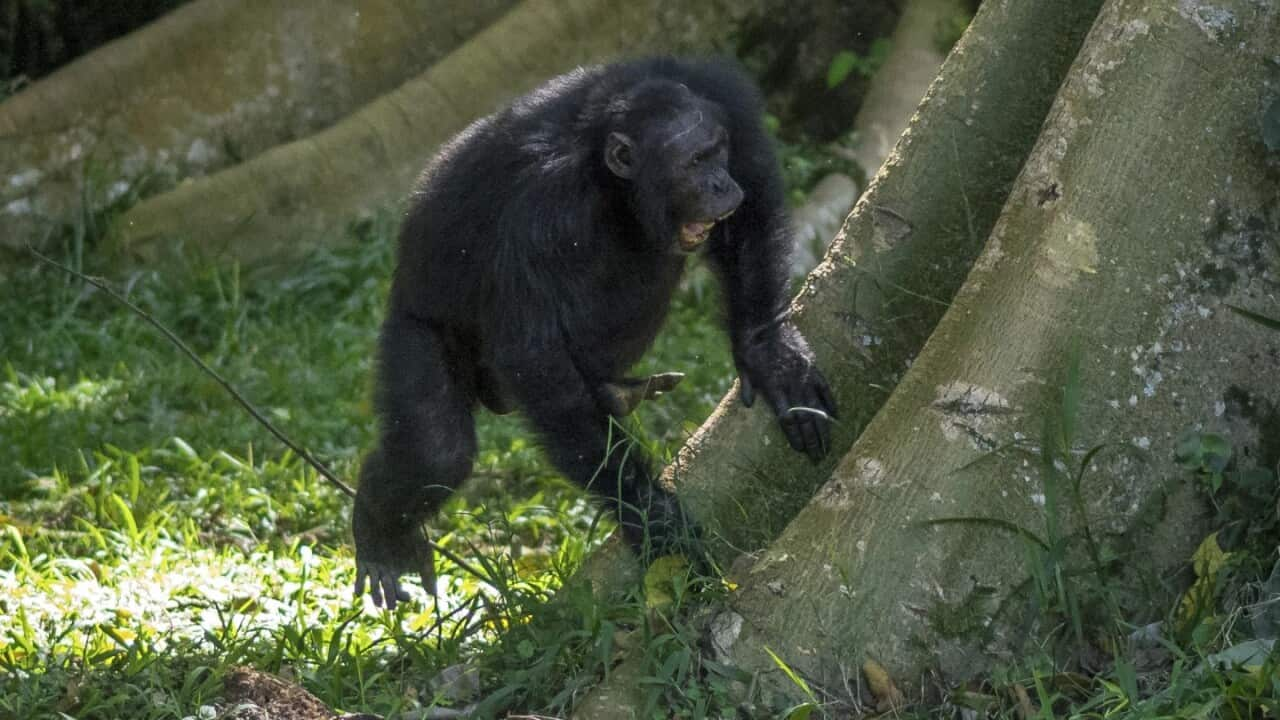TRANSCRIPT
(The sound of chimpanzees screeching and drumming)
This chimpanzee in western Africa is using a signature rhythm in its drumming according to scientists from a study that's just been published.
This chimpanzee is listening to vocal sounds then responding and drumming.
The new study shows chimpanzees drum with regular rhythm when they beat on tree trunks.
Lead author Professor Catherine Hobaiter, from the school of psychology and neuroscience at the University of St Andrews, recorded video of the chimps drumming.
Previous research has also shown that chimps in regions of west and east Africa have their own signature drumming style.
Professor Hobaiter says there is a distinct difference in the tempo of the drumming.
"The chimpanzees will drum on almost anything, and some chimpanzee groups live in places with very few trees or just small buttress roots, but if they get the chance, the buttressed roots of these trees, the sort of big triangular supporting structures and they would grab a hold of them with one or both hands, and they'll be kicking their feet off them to get those powerful long distance beats. But they'll also be like throwing in some hand beats and things in there. And they can really develop their incredibly fast when they drum, actually much faster than most human drummers can drum at, so they're really high tempo, lots of energy and each drum, each chimpanzee drummer has their own individual signature when they're drumming, so if I hear a chimp drumming I know if it's Fred or Bob in the forest."
A new analysis of 371 bouts of chimpanzee drumming demonstrates that the chimps clearly play their instruments - the tree trunks - with regular rhythms.
It reflects data that was collected by an international team of researchers over many years.
The study in the journal Current Biology suggests that the ability to produce rhythm predates the last common ancestor of humans and chimpanzees, dating back more than six million years.
(The sounds of chimps screeching and drumming)
When bounding through the jungle, these chimps will often grab hold of the large roots of rainforest trees that grow above the soil.
Sometimes they pound them several times to create low-frequency sounds that can be heard for a kilometre or more through the forest.
Scientists believe the drumming is a form of long-distance communication, perhaps to alert other chimps where one chimp is waiting - or the direction it is traveling as Professor Hobaiter explains.
"First of all, it shows that in their natural behaviour, when they can fully express it in the wild, they do have a capacity for rhythm, they're using that in their social behaviour, in their social communication, just as we do. So one of the rhythms is something we call asynchrony, it's a bit like a metronome or a ticking clock. It's a very regular beat. That's what chimpanzees in West Africa use. Chimpanzees in East Africa are using long, short, long, short intervals, sort of, you know, beat, beat, space beat beat, space."
(The sound of chimps hooting and drumming)
This behaviour is not observed in chimpanzees outside of the wild according to the scientists.
And Professor Hobaiter says the team of researchers are trying to solve the conundrum of where the rhythm comes from.
"The few studies that had been done on captive apes suggested that actually they have a really difficult time with rhythm and that it wasn't maybe a natural capacity that they had. So we weren't sure what we would find, but we wanted to take a look at it because we knew that these drums are a really important component of chimpanzee social lives and also that rhythm, and we needed to find the sort of a solution to this puzzle of where did rhythm come from. If we didn't inherit it from an older ancestor? Is it really just something that makes humans human."
According to Professor Hobaiter, the drumming may also be able to identify other chimp communities and is a rich way of communicating over long distances.
"So they have a lot of flexibility in their drumming and it gives them lots of opportunity to encode all kinds of information on who's drumming, where in the forest they are, what their activity is. So it's a really rich way of communicating long distance for them."













